Introduction
Products and services have been sold on a subscription basis for decades. However, in recent years the subscription business model has gained popularity thanks to the increase in content consumption. Enterprises and solopreneurs alike process subscriptions to monetize the constantly growing demand for web content and generate a steady stream of recurring revenue.
Whether it offers tangible goods, software solutions, news, or entertainment, a subscription website is at the core of every subscription business. Set your subscription business up for success - learn how to create a subscription website and ensure it has all it needs to operate flawlessly.
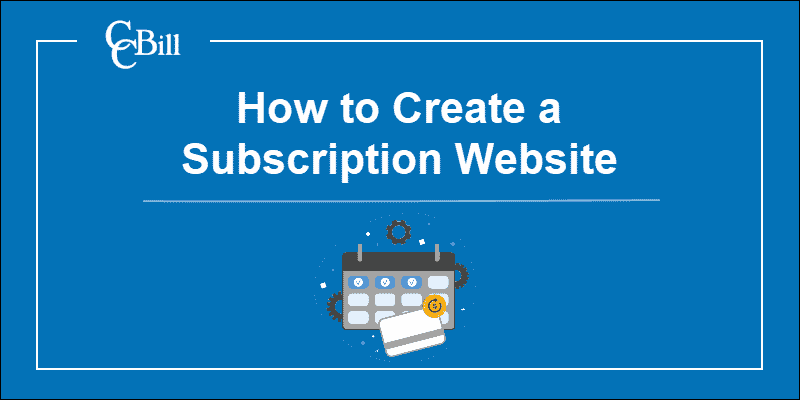
What Is a Subscription Website?
A subscription website is a website (or a section of one) that offers visitors access to physical or digital goods or services in exchange for website membership and a subscription fee.
Note: While subscriptions require website membership, not all membership websites are used for subscriptions. For an in-depth take on the subject, read our article Subscription vs. Membership: What’s the Difference?
In recent years, the subscription business model has grown in popularity. This expansion is attributed to the following:
- Customers prefer renting over buying. According to JLL, 57,3% of customers would rather rent a product than own it, especially if the products are trendy and of good quality. In addition, Cerillion claims that customers look at subscriptions as small individual expenses instead of a single total amount of money spent on a product/service. This means that customers gravitate towards spending more on subscriptions than one-time payments.
- Businesses offering subscriptions are growing rapidly. According to The Paypers, an average subscription vendor grows 30-50% annually.
8 Steps for Creating a Subscription Website
Subscription websites are the core component of subscription businesses, and creating one takes careful planning.
To create a subscription website:
- Choose a niche.
- Decide on a content format.
- Choose a subscription model.
- Choose a subscription website builder.
- Define subscription plans and pricing.
- Choose a subscription payment processor.
- Implement paywalls.
- Employ marketing.
1. Choose a Niche
Before starting any business, including a subscription website, business owners must choose a niche.
A subscription-based business model can be applied to most niches. The recommended practice for business owners is to choose a niche that aligns with their personal interests. This ensures the business owner has the expertise necessary to determine product demand and the buyer persona as well as create the best possible subscription tier system.
The most popular niches for subscription businesses include:
- Entertainment (gaming, music streaming, video streaming)
- Food
- Cosmetics
- Business or life coaching
- Dating
- Adult content
2. Decide on a Content Format
The most valuable asset of a subscription website is the content to which it gives access via subscriptions.
In theory, any kind of product or service, be it digital or physical, can be offered on a subscription basis. However, there are certain products and services that naturally lend themselves to this kind of business model. Typically, they are items or services that customers need or want on a regular basis.
The most popular types of content offered as a subscription include:
- Physical products: cosmetics, food, collectibles, DIY kits, mystery boxes, pet products, etc.
- Digital products: photographs, videos, software, software plugins and libraries, recorded lessons, digital art, access codes, discount codes, etc.
- Live calls: online meet-and-greets, workshops, lessons, live cams, etc.
- Access to physical or digital locations: amusement parks, sporting events, concert livestreams, seminars and webinars, social media communities, etc.
Anything being sold in person or online must abide by certain laws and regulations. These laws will depend on the territory where the business operates and the type of products or services it offers. Aside from laws and regulations, the only limitation businesses have regarding their subscription offering is to keep it relevant to the brand’s mission, vision, and goals.
3. Choose a Subscription Model
The content a subscription business offers directly impacts the subscription model it will use. There are three subscription models:
- Curated subscriptions. These involve sending subscribers a specific selection of products that changes periodically. An example of a curated subscription model is BirchBox, a beauty and health product company that creates bespoke orders based on subscribers’ answers to a quiz about personal preferences.
- Recurring replenishment subscriptions. This model refers to sending subscribers the same products they ordered in their first purchase. Subscribers typically have the option to modify orders if necessary. Examples of the recurring replenishment subscription model are grocery and meal delivery services, such as ButcherBox, HelloFresh, and Blue Apron.
- Access subscriptions. This model allows subscribers limited access to digital or physical content based on their subscription tier. Tiers vary by duration and the amount of content to which they provide access. For example, subscribing to Amazon Prime grants users free shipping on select Amazon products, ad-free music, movies and tv-shows, games and in-game content, etc.
4. Choose a Subscription Website Builder
A subscription website can be designed and developed from scratch or through an all-in-one content management system, hosting provider, and website builder.
Hiring developers to build a website gives creative freedom but is typically not an option for startups since the process is costly and time-consuming. Subscription website builders are quick, easy to use (even without coding knowledge), and much more affordable.
The most popular subscription website builders are:
5. Define Subscription Plans and Pricing
Most subscription businesses abide by the rule of three, which is the belief that the human brain prefers things that come in threes. Implementing this belief in a subscription business results in three distinct pricing tiers:
- The basic tier. Offers the least perks and serves to tempt subscribers to upgrade. The basic tier is free or features the lowest price but comes with a free trial.
- The premium (middle) tier. Features everything the basic tier includes with extra perks and benefits. The premium or middle tier should have the best price-to-perks ratio and be presented as the optimal option for most users. It is standard practice to highlight this tier or mark it with a recommended tag.
- The professional tier. Features the highest price because it includes everything from the previous tiers and exclusive access to additional functionalities, content, or rewards.
Note: Find out which 4 Subscription Pricing Models for Recurring Revenue yield the best results and how to choose the right one for your online business.
Some businesses decide to offer four tiers, the first one being free, and the other three as described above. Offering more than four or less than three tiers is considered suboptimal. Two tiers are too little to choose from, and five or more options overwhelm the user.
Regardless of how many tiers a business decides to offer, they must be designed with the customers’ needs in mind. While businesses may have a specific audience, different buyer personas will be drawn to different subscription tiers. Buyer personas differ based on their budget, level of interest, perception of value, and other factors.
Note: Read our article What Is a Buyer Persona and How Is It Used? to find out how to identify and win over different types of buyers.
Conduct thorough market research before deciding on how many tiers you will have and what they will offer to ensure they cater to the business’s target audience.
6. Choose a Subscription Payment Processor
A subscription payment processor is responsible for ensuring all recurring payments from subscribers are handled quickly and securely.
The characteristics of a good subscription payment processor are as follows:
- Has the ability to scale services as the number of subscribers increases.
- Implements the latest security updates and practices.
- Provides around-the-clock merchant support and customer service.
Note: If you are looking for an online payment service provider, CCBill’s subscription payment processing solution is designed to support all subscription business models out-of-the-box.
7. Implement Paywalls
A paywall is a barrier between a website visitor and the content that unlocks with membership and subscription. The paywall’s task is to authenticate membership and subscription, identify the subscription tier, and provide access to the content the tier is eligible for.
Note: Paywalls are explicitly used by news portals and content creators. Businesses that do not fall under these categories can skip this step.
Paywalls are typically available as plugins within subscription website builders, making them easy to set up. Consult customer support of your chosen subscription website builder to learn more about available paywall options and identify the best one for your business.
Note: Read our article to discover the Best Paywall Platforms and Solutions for Publishers.
8. Marketing
Like any other business, subscription businesses can be marketed via traditional and digital means. Regardless of the marketing medium, marketing strategies for subscription businesses require a specific approach.
Ecommerce marketing typically entails shorter promotional campaigns, short-term goals, and quick wins (sales). On the other hand, the focus of subscription marketing lies in customer retention and the creation of repeat customers. Such customers ensure that the business has a guaranteed recurring revenue stream.
One way to increase customer retention is to monitor and improve customer lifetime value (CLV): To do that:
- Create and maintain flawless and engaging customer experiences.
- Prevent churn and reduce the current churn rate.
- Offer rewarding cross-sells and upsells.
- Develop rewarding loyalty programs.
- Follow marketing trends to keep marketing the same product in a fresh and engaging way.
- Implement customer feedback.
5 Good Subscription Website Examples
There are countless examples of successful subscription websites online, but the following stand out based on their selling points.
Tinder
Tinder is a free online dating and networking platform that offers extra functionalities in three subscription tiers – Plus, Gold, and Platinum.
Plus is the basic subscription tier that allows subscribers to remove ads and rewind profiles they accidentally rejected.
Gold gives users the perks of Tinder Plus with additional benefits, such as the ability to see who liked their profile, receive top profile picks, get one free profile boost (enhanced profile visibility) per month, and five super likes per week.
Platinum is the highest subscription tier and allows users to access all features from lower tiers, see all profiles they liked within the past week, and message profiles they have not matched with.
The subscription tiers are carefully designed to cater to different users’ needs. The success of this tier system is reflected in the fact that Tinder is the most popular dating service.
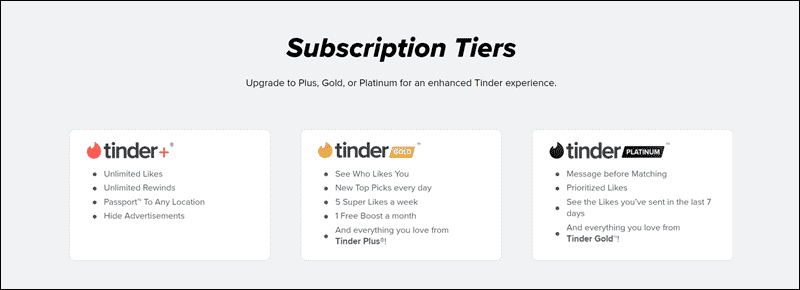
Netflix
Netflix is the most popular on-demand streaming service in the world. Part of that success can be attributed to its well-designed subscription tiers.
The three tiers differ in the following factors:
- Number of simultaneous streams allowed.
- Number of devices that can have downloaded content at a time.
- Maximum video quality.
The price difference between the tiers is minimal, making the service affordable to subscribers with diverse needs and budgets.
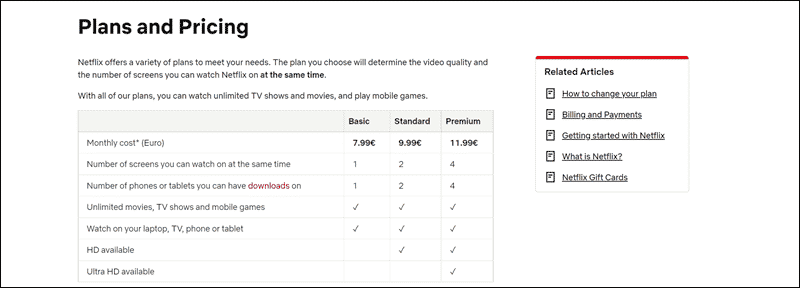
Trello
Trello is a project management Software-as-a-Service that offers a forever-free subscription tier (accessed via membership) and three paid tiers.
The three paid tiers differ in:
- Functionalities
- Number of boards allowed in a workspace
- Number of workspaces that can be created
- Workspace views
- Number of users that can access a workspace
- File size limits
- Permission management
- Security features
Trello’s target audience are schools and companies, the free tier catering to the former while the other tiers meet the needs of the latter. One of the main selling points of Trello is that the subscription is scalable, and enterprises may become eligible for a discount based on the number of users the subscription is ordered for.
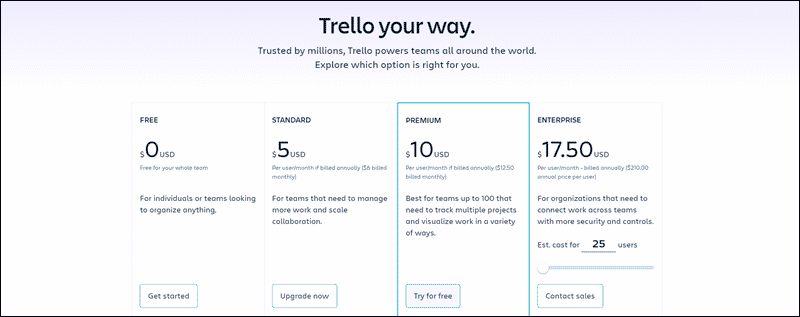
Grammarly
Grammarly is a Software-as-a-Service solution that corrects grammar and tone, detects plagiarism, and improves writing. It features a free tier and two paid tiers – Grammarly Premium and Grammarly Business.
Grammarly Premium gives subscribers access to everything the app has to offer. Grammarly Business is the same as premium, with additional features such as style guides, snippets, brand tones, writing analytics, and account permissions.
What makes Grammarly stand out among other subscription businesses is the price difference based on the length of the subscription. Users pay monthly, quarterly, and annually to gain access to the service.
The selling point of Grammarly is that it speeds up writing and makes any written work sound the way the writer wants it to. As a result, Grammarly users become dependent on the software and loyal subscribers. In addition, Grammarly incentivizes users to subscribe for longer periods of time by offering discounts for quarterly and annual subscriptions. Enterprises also get a personalized quote based on the expected number of users.
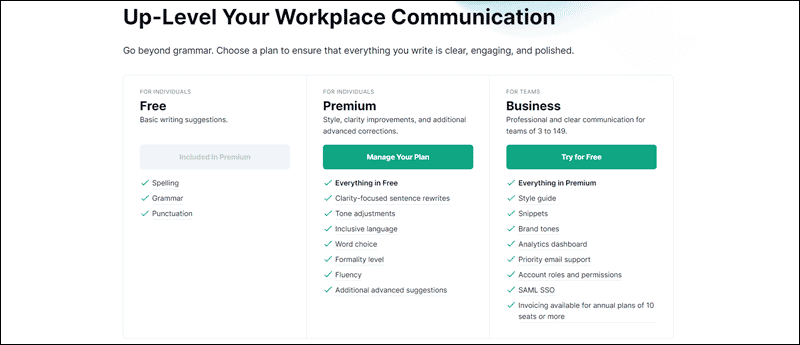
Xbox Game Pass
The Xbox Game Pass subscribers gain early access to new games as well as continuous access to older titles as long as they renew their subscription.
The Xbox Game Pass comes with three tiers – PC, Console, and Ultimate (PC, console, and cloud). The console and PC tier are $9.99, while the Ultimate is $14.99.
The selling point of this subscription is the device the subscriber uses to play games. Most subscribers play on either a PC or console, but those who enjoy playing on both devices can do so for a price slightly lower than that of two individual subscriptions.
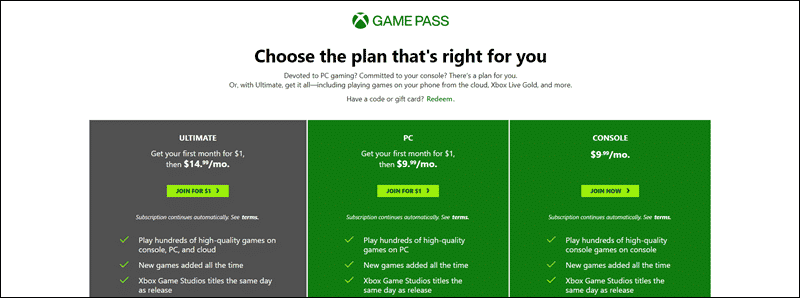
Benefits of Owning a Subscription Website
Owning a subscription website provides businesses with the following benefits:
- Better financial forecasting. Subscription businesses that implement quarterly and annual subscriptions can better predict future income and make smarter financial decisions.
- Better customer acquisition and retention. New customers typically do not subscribe unless they plan to stay for the long run. Likewise, existing customers are unlikely to unsubscribe unless a drastic change occurs in the terms of use, pricing, and so on.
- Improved inventory management. Subscription businesses better anticipate demand and supply, resulting in optimal inventory management.
- Better cash flow. Automating recurring billing ensures stable and predictable cash flow.
- Easy scalability. Compared to other business models, a subscription business is easier to upscale and downscale, when necessary.
- Upselling opportunities. Once subscribed, customers are more likely to respond positively to subscription upgrade offers.
Conclusion
The subscription business model is not new but has recently experienced rapid growth. It is now well-established as an effective way of selling a variety of products or services.
Customers appreciate being able to rely on receiving a product or service when they need it while merchants enjoy the predictability of revenue this model offers. Take advantage of these benefits and consider offering your products or services on a subscription basis. Use this guide to kickstart your business venture.
